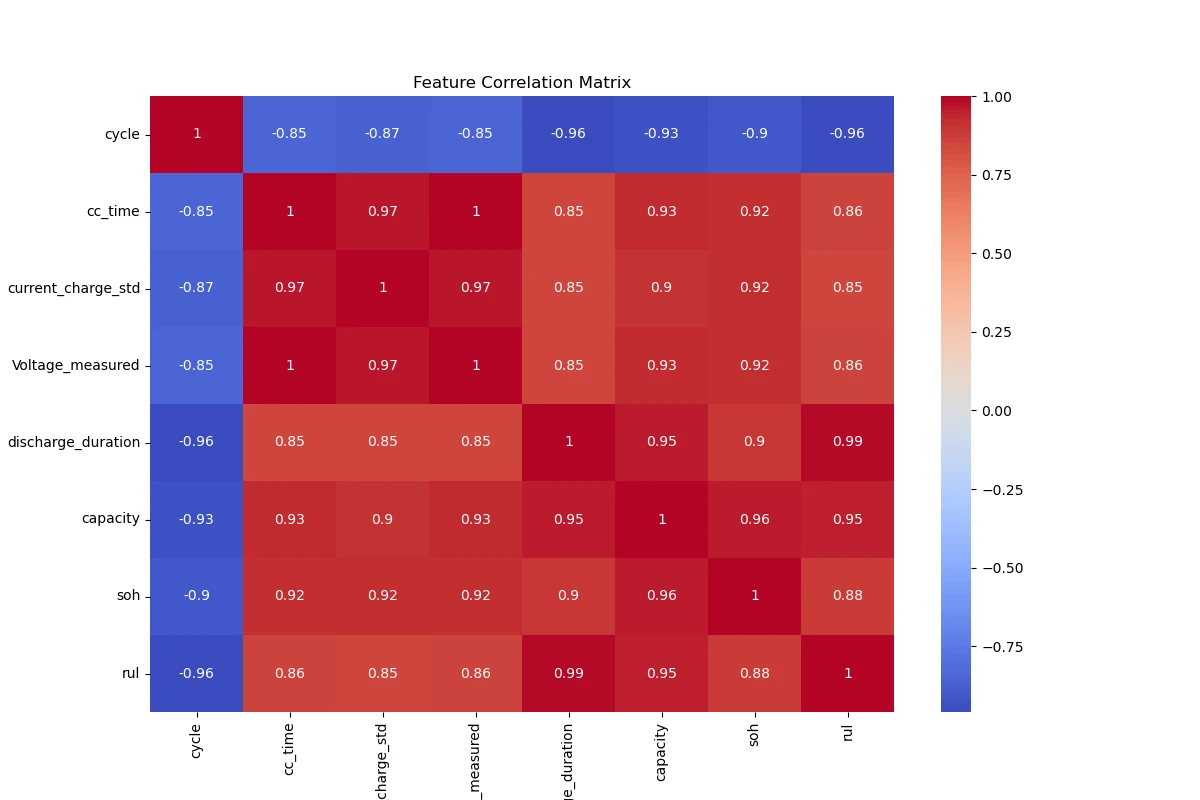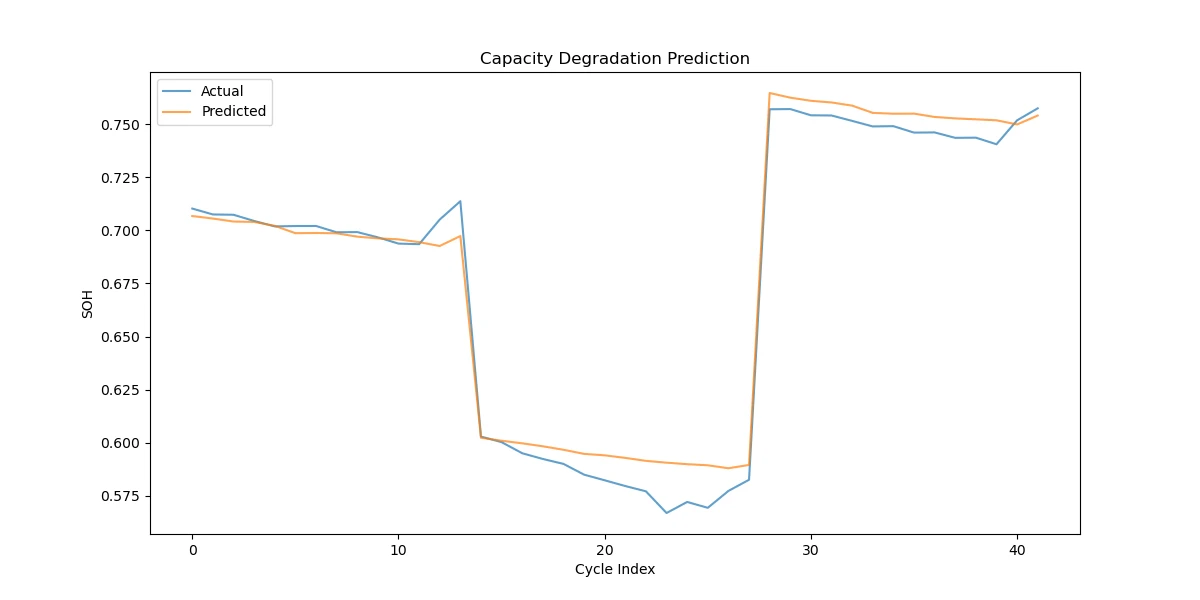本文主要介绍如何使用 LSTM 预测电池的 SOH (SOC)。
项目地址:https://github.com/zhang3399/Battery-SOH-prediction
# 1. 数据集介绍
数据集来源于 https://ti.arc.nasa.gov/tech/dash/groups/pcoe/prognostic-data-repository/#battery
数据说明:
一组四个锂离子电池(#5、6、7 和 18)在室温下经历了 3 种不同的操作模式(充电、放电和阻抗)。以 1.5A 的恒流(CC)模式充电,直到电池电压达到 4.2V,然后以恒压(CV)模式继续充电,直到充电电流降至 20mA。以 2A 的恒定电流(CC)水平进行放电,直到电池 5、6、7 和 18 的电池电压分别降至 2.7V、2.5V、2.2V 和 2.5V。通过电化学阻抗谱(EIS)从 0.1Hz 到 5kHz 的频率扫描进行阻抗测量。重复的充电和放电循环导致电池加速老化,而阻抗测量则提供了对随着老化过程而变化的内部电池参数的洞察。当电池达到寿命终止(EOL)标准时,实验停止,即额定容量下降 30%(从 2Ahr 降至 1.4Ahr)。该数据集可用于预测剩余电荷(对于给定的放电循环)和剩余使用寿命(RUL)。
文件清单:
(项目目录下 path.xlsx 统计的充放电循环周期)
| 文件名 | 电池编号 | 循环次数 | 数据规模 |
|---|---|---|---|
B0005.mat |
5 | 167 | 15.2MB |
B0006.mat |
6 | 167 | 15.2MB |
B0007.mat |
7 | 167 | 15.3MB |
B0018.mat |
18 | 132 | 8.1MB |
数据结构:
- cycle:包含充电、放电和阻抗操作的顶层结构阵列
- type:充电、放电或阻抗 (charge, discharge or impedance)
- ambient_temperature:环境温度(摄氏度)
- time:周期开始的日期和时间,采用 MATLAB 日期向量格式
- data:包含测量值的数据结构
- charge 充电类型字段为:
- Voltage_measured:蓄电池端子电压(伏特)
- Current_measured:电池输出电流(安培)
- Temperature_measured:电池温度(摄氏度)
- Current_charge:在充电器处测量的电流(安培)
- Voltage_charge:在充电器处测量的电压(伏特)
- Time:周期的时间矢量(秒)
- discharge 放电类型字段为:
- Voltage_measured:蓄电池端子电压(伏特)
- Current_measured:电池输出电流(安培)
- Temperature_measured:电池温度(摄氏度)
- Current_charge:负载下测量的电流(安培)
- Voltage_charge:负载下测量的电压(伏特)
- Time:周期的时间矢量(秒)
- Capacity:放电至 2.7V 的电池容量(Ahr)
- impedance 阻抗类型字段为:
- Sense_current:感测支路中的电流(安培)
- Battery_current:电池支路中的电流(安培)
- Current_ratio:上述电流的比率
- Battery_impedance:根据原始数据计算的电池阻抗(欧姆)
- Rectified_impedance:校准和平滑的电池阻抗(欧姆)
- Re:估计电解质电阻(欧姆)
- Rct:估计的电荷转移电阻(欧姆)
- charge 充电类型字段为:
# 2. 数据预处理
提取数据:
考虑阻抗测试数据并不是与充放电周期进行,因此,我们只考虑充放电周期数据,并将相邻的充放电周期数据合并作为一组数据。
而且训练的输入特征并不是越多越好,通过 pandas 的 corr () 函数分析,发现一些特征与 SOH 相关性较低,因此我们选择一些关键特征,如充电时间、充电电流标准差、放电时间和放电容量,这些特征与 SOH 的相关性较高,分析结果采用热力图如下:

def extract_operation_features(cycle): | |
## 提取单个操作的特征 | |
features = {} | |
data = cycle['data'] | |
try: | |
if cycle['type'] == 'charge': | |
# 提取充电特征 | |
features.update({ | |
'cc_time': np.argmax(data['Voltage_measured'] >= 4.2) / len(data['Time']), # 恒流阶段占比 | |
'current_charge_std': np.std(data['Current_measured']), | |
'Voltage_measured': np.argmax(data['Voltage_measured'] >= 4.2) / len(data['Time']), | |
}) | |
elif cycle['type'] == 'discharge': | |
# 提取放电特征 | |
features.update({ | |
'discharge_duration': data['Time'][-1] - data['Time'][0], | |
'capacity': data['Capacity'] # 取最终放电容量 | |
}) | |
except KeyError as e: | |
print(f"特征提取错误: {str(e)}") | |
return features |
数据集划分方式:
df是划分的数据集,是上一步提取包含 5、6、7、18 号电池的特征信息。div_batt是用于划分训练集和测试集电池 ID 列表,这里是 [‘05’, ‘06’, ‘07’]。test_ratio控制划分比例test_new_batt是用于将全新电池作为测试集电池 ID,这里是’18’。
函数处理返回两种验证集 pd.concat(val_dfs) , final_test_df 。
pd.concat(val_dfs)按照将 div_batt 列表电池的后 20% 作为测试集。final_test_df将test_new_batt号电池作为测试集。
# 划分数据集为训练集和测试集 | |
def create_hybrid_split(df, div_batt, div_name, test_ratio=0.2, test_new_batt=None): | |
# 划分数据集为训练集和测试集 | |
# df: 数据集 | |
# div_batt: 电池 ID 列表' | |
# div_name: 按照该属性值划分 | |
# test_ratio: 测试集比例(充放电周期数据前一部分为训练集,后面为测试集,保证无交叉) | |
# test_new_batt: 新的一组电池作为测试集(可选) | |
final_test_batt = test_new_batt | |
final_test_df = df[df[div_name] == final_test_batt] | |
# 其他电池内部按时间划分 | |
train_dfs, val_dfs = [], [] | |
for batt_id in div_batt: | |
batt_data = df[df[div_name] == batt_id] | |
split_idx = int(len(batt_data) * (1 - test_ratio)) | |
train_part = batt_data.iloc[:split_idx] | |
val_part = batt_data.iloc[split_idx:] | |
train_dfs.append(train_part) | |
val_dfs.append(val_part) | |
return pd.concat(train_dfs), pd.concat(val_dfs), final_test_df | |
# 开始数据集的划分 | |
all_data = [] | |
for batt_id in ['05', '06', '07', '18']: # 遍历电池数据 B005.mat, B006.mat, B007.mat, B0018.mat | |
print(f"Processing battery {batt_id}...") | |
cycles = load_battery_data(batt_id) # 数据加载 | |
current_cycle_num = 0 # 独立维护每个电池的周期计数器 | |
last_charge_features = {} # 存储最近一次充电特征 | |
initial_capacity = None | |
for cycle in cycles: | |
# 跳过阻抗测试 | |
if cycle['type'] == 'impedance': | |
continue | |
# 提取基础特征 | |
features = extract_operation_features(cycle) | |
if cycle['type'] == 'charge': | |
# 缓存充电特征,等待后续放电配对 | |
last_charge_features = features | |
elif cycle['type'] == 'discharge' and last_charge_features != {}: #开始为放电则跳过,确保构建(充电 - 放电)周期 | |
if not last_charge_features: | |
print(f"Warning: 放电周期 {current_cycle_num} 缺少充电数据") | |
continue | |
# 合并特征 | |
full_features = { | |
'battery_id': batt_id, | |
'cycle': current_cycle_num, | |
**last_charge_features, | |
**features | |
} | |
# 初始化容量记录 | |
if initial_capacity is None: | |
initial_capacity = full_features['capacity'] | |
print(f"电池 {batt_id} 初始容量: {initial_capacity:.2f}Ah") | |
# 计算健康指标 | |
full_features['soh'] = full_features['capacity'] / initial_capacity | |
all_data.append(full_features) | |
# 周期计数器递增 | |
current_cycle_num += 1 | |
last_charge_features = {} # 重置缓存 | |
# 转换为 DataFrame | |
df = pd.DataFrame(all_data) |
数据集划分:
这里可以设置 train_batt_ids , test_batt_ids ,来选择上面提到的测试集划分方式,要取消几处可选的注释。
df = create_dataset() | |
# 定义特征列(根据最新特征工程调整) | |
feature_cols = [ | |
'cc_time', | |
'current_charge_std', | |
'Voltage_measured', | |
'discharge_duration', | |
'capacity' | |
] | |
# 读取 config.yaml 定义的目标列 | |
target_col = config['data']['target_col'] | |
# 按电池 ID 划分数据集(严格隔离) | |
train_batt_ids = ['05', '06', '07'] # 划分训练集、测试集数据 | |
# test_batt_ids = '18' # 测试完整新电池数据(可选) | |
train_df, test_df, final_test_df = create_hybrid_split(df, | |
div_batt=train_batt_ids, | |
div_name='battery_id', | |
test_ratio=config['data']['test_ratio'], | |
# test_new_batt=test_batt_ids #(可选) | |
) | |
# test_df = final_test_df #(可选) | |
# 特征标准化(仅在训练数据上拟合) | |
scaler = StandardScaler() | |
train_df[feature_cols] = scaler.fit_transform(train_df[feature_cols]) | |
test_df[feature_cols] = scaler.transform(test_df[feature_cols]) |
实验发现,将数据的前一部分用于训练,后一部分用于测试,预测精度高一些。如果采用一组新的电池如 B0018 号则效果会略微下降,这可能是数据量还是太少的原因,模型泛化能力不足。
# 3. 模型构建
模型采用 LSTM(Long Short-Term Memory)网络,用于预测电池的 SOH。
class BatteryLSTM(nn.Module): | |
def __init__(self, input_size, hidden_size, num_layers, dropout, output_size): | |
super().__init__() | |
self.lstm = nn.LSTM( | |
input_size=input_size, | |
hidden_size=hidden_size, | |
num_layers=num_layers, | |
dropout=dropout, | |
batch_first=True | |
) | |
self.fc = nn.Sequential( | |
nn.Linear(hidden_size, 32), | |
nn.ReLU(), | |
nn.Dropout(dropout), | |
nn.Linear(32, output_size) | |
) | |
def forward(self, x): | |
out, (h_n, c_n) = self.lstm(x) | |
out = self.fc(out[:, -1, :]) | |
return out |
# 4. 模型训练
模型训练包括模型参数设置、模型训练、模型评估等步骤。
关于精度可以尝试调整模型参数,如隐藏层大小、层数、dropout 率等,以获得更好的性能。
序列长度 seq_length 不大的话,隐藏层不需要太大我习惯分别尝试为 [32, 64, 128, 256]。
data: | |
sequence_length: 10 | |
test_ratio: 0.2 | |
target_col: "soh" | |
model: | |
input_size: 5 | |
hidden_size: 128 | |
num_layers: 2 | |
dropout: 0.3 | |
output_size: 1 | |
training: | |
epochs: 300 | |
batch_size: 8 | |
learning_rate: 0.001 | |
patience: 20 |
# 5. 模型预测
各项指标:
======== 最终模型评估指标 ======== | |
MSE: 0.0001 | |
RMSE: 0.0090 | |
MAE: 0.0070 | |
R²: 0.9838 |
预测结果:

图片这样是因为预测的是 5、6、7 号电池的后 20% 个周期的 SOH,因为偷懒未单独对每个电池进行处理,想好看一点可以在前面讲的,将 18 号电池单独作为测试集。